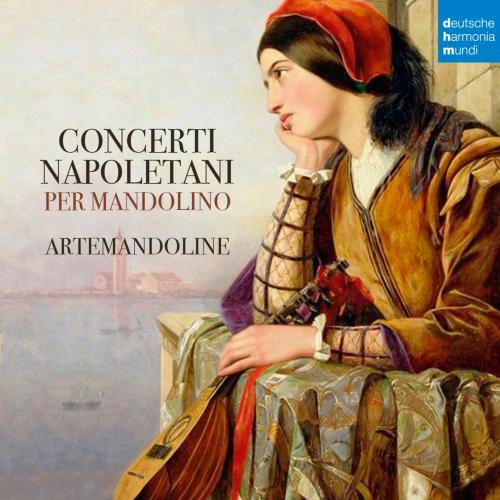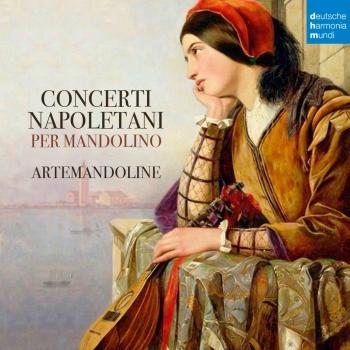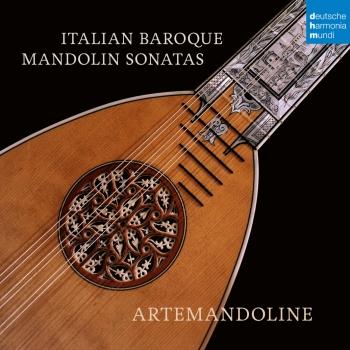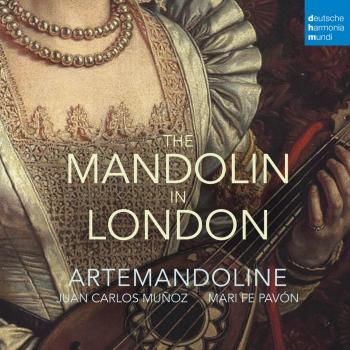
Concerti Napoletani per Mandolino ArteMandoline
Album Info
Album Veröffentlichung:
2018
HRA-Veröffentlichung:
27.07.2018
Label: deutsche harmonia mundi
Genre: Classical
Subgenre: Chamber Music
Interpret: ArteMandoline
Komponist: Giovanni Paisiello (1740-1816), Carlo Cecere (1706-1761)
Das Album enthält Albumcover Booklet (PDF)
Entschuldigen Sie bitte!
Sehr geehrter HIGHRESAUDIO Besucher,
leider kann das Album zurzeit aufgrund von Länder- und Lizenzbeschränkungen nicht gekauft werden oder uns liegt der offizielle Veröffentlichungstermin für Ihr Land noch nicht vor. Wir aktualisieren unsere Veröffentlichungstermine ein- bis zweimal die Woche. Bitte schauen Sie ab und zu mal wieder rein.
Wir empfehlen Ihnen das Album auf Ihre Merkliste zu setzen.
Wir bedanken uns für Ihr Verständnis und Ihre Geduld.
Ihr, HIGHRESAUDIO
- Giovanni Paisiello (1740 - 1816): Mandolin Concerto in E-Flat Major:
- 1 Mandolin Concerto in E-Flat Major: I. Allegro maestoso 04:59
- 2 Mandolin Concerto in E-Flat Major: II. Larghetto grazioso 06:00
- 3 Mandolin Concerto in E-Flat Major: III. Allegretto 04:45
- Giuseppe Giuliano (18th century): Mandolin Concerto in B-Flat Major:
- 4 Mandolin Concerto in B-Flat Major: I. Maestoso 04:01
- 5 Mandolin Concerto in B-Flat Major: II. Lento non troppo 02:23
- 6 Mandolin Concerto in B-Flat Major: III. Allegro 03:04
- Domenico Gaudioso (18th century): Mandolin Concerto in G Major:
- 7 Mandolin Concerto in G Major: I. Allegro 05:07
- 8 Mandolin Concerto in G Major: II. Largo 04:29
- 9 Mandolin Concerto in G Major: III. Allegro 03:42
- Carlo Cecere (1706 - 1761): Mandolin Concerto in A Major:
- 10 Mandolin Concerto in A Major: I. Allegro ma non presto 03:49
- 11 Mandolin Concerto in A Major: II. Largo 03:02
- 12 Mandolin Concerto in A Major: III. Grazioso 02:28
- Giovanni Paisiello: Mandolin Concerto in C Major:
- 13 Mandolin Concerto in C Major: I. Tempo giusto 06:49
- 14 Mandolin Concerto in C Major: II. Larghetto alla siciliana 03:50
- 15 Mandolin Concerto in C Major: III. Allegro 05:56
Info zu Concerti Napoletani per Mandolino
Für ihr erstes Album "Sospiri d'amanti" mit der spanischen Sopranistin Nuria Rial wurde das Alte Musik Ensemble Artemandoline hochgelobt: "Hier singen die Mandolinen, dass es eine Lust ist" (Opernwelt). Mit ihrem zweiten Album nehmen sie den Hörer mit auf eine musikalische Reise ins Neapel des 18. Jahrhunderts. Egal ob im Opernhaus, in den Theatern oder Konservatorien - Musik war in Neapel allgegenwärtig. Sie spielte eine wichtige Rolle in den zahllosen Salons und in den Palästen, wo sich der Klerus, die Mäzene, die Musikliebhaber und Förderer der Künste begegneten. So verwundert es nicht, dass sich nicht nur die berühmte, eigenständige Opern-Stilrichtung der Neapolitanischen Schule, sondern auch eine "neapolitanische Mandolinenschule" mit ihrer eigenen Tonsprache und spezifischen Techniken herausbildete. Das Ensemble Artemandoline hat als Weltersteinspielung erstmals auf Originalinstrumenten der Barockzeit fünf entdeckenswerte neapolitanische Konzerte ausgewählt, die ungewohnte und hochinteressante Aspekte der italienischen Instrumentalmusik zeigen. Dabei faszinieren diese barocken Konzerte von Komponisten wie Giovanni Paisiello (1740-1816), Giuseppe Giuliano (18. Jhd.), Domenico Caudioso (18. Jhd.) sowie Carlo Cecere (1706 - 1761) mit vielfältigen harmonischen Wendungen, verzierenden Details sowie ihrem großen melodischen Einfallsreichtum.
ArteMandoline Barockensemble
Juan Carlos Muñoz, Mandoline
Mari Fe Pavón, Mandoline
Alla Tolkacheva, Mandoline
Artemandoline
With their ensemble Artemandoline, formed in 2001, Juan Carlos Muñoz and Mari Fe Pavón chose to go back to the original documents in order to the establish the true pedigree of this incomparable family of instruments. They have made a major contribution to launching a movement to encourage musical freshness and rigour. A better understanding of the compositions, closer study of the early treatises, the playing styles, the musical environment of the glorious era of the mandolin, leads to better appreciation of Baroque music, which itself became over time a mode of thought and action.
Searching for early mandolins, working on the manuscripts, hunting down early treatises, exploring the iconography: these are the means by which, for more than ten years now, the musicians of Artemandoline have sought to do fuller justice to the works of Scarlatti, Vivaldi, Weiss, and their contemporaries. The success of this approach based on a return to the sources, which constitutes the most important development in the history of the interpretation of ‘serious’ music in the course of the twentieth century, has been made possible by the cooperation of many protagonists – musicians, but also concert organisers, recording producers, publishers, musicologists, and instrument makers.
To ensure that music composed in the past does not sound like mere ‘early music’ in the present, the performers must manage to be sufficiently free, spontaneous, anticipative and astonished in their intimate act of creation and the newness it engenders. Juan Carlos Muñoz and Mari Fe Pavón spend their lives searching out and reviving forgotten masterpieces of the mandolin repertory. They are not content with simply presenting their finds like ‘musical archaeologists’, but endeavour to transmit them to the wider public by means of the essential act of communication between interpreters, composers, and listeners.
Very quickly awarded prizes by the critics and enthusiastically acclaimed by the public, Artemandoline’s performances always create new impulsions in the development of both the perception and the interpretation of the works of the seventeenth and eighteenth centuries. Its musicians dedicate their time and their talents to the revival of the mandolin on the musical scene, participating in the current expansion of interest in it all over the world through their conservatory teaching and masterclasses, their concerts, and their publications. Artemandoline is one of the pioneers in this domain, in which it has forged an international reputation.
In a few short years, the ensemble has found its style, proved its instrumental quality, and thereby constituted a veritable identity. Soon after its formation, it took its place among the foremost ensembles in the realm of historical performance practice on plucked strings. Audiences and critics alike were immediately filled with enthusiasm for its lively musical style.
The musicians who make up the ensemble play on period instruments: Baroque mandolins, Renaissance and Baroque guitar, Baroque mandola and mandolone, Renaissance lute, treble lutes, mandolins from Brescia and Cremona.
They are regularly invited to appear at early music festivals in France and abroad, including the Festival de Musique Ancienne du Marais, Festival du Périgord Vert, the « Tage Alter Musik Regensburg » in Germany ; « Early Music Day Alden-Biesen (Belgique) », Musique en Catalogne romane, Festival de l’Épine in France; Monza e Brianza, Gaudete Early Festival (Piedmont), and Castello Reale di Sarre (Aosta), all in Italy; Narol and Wroclaw in Poland; the Baroque Days at the Philharmonie in Luxembourg;; the Bach Chamber Days in Riga (Latvia); Festival Musique d’Ensemble à Pommiers, Oissery, Sedan, and other engagements in Spain, Japan, Switzerland, and Algeria.
The ensemble Artemandoline is in residence at the Romanesque church of Mont St Martin (Longwy, Meurthe-et-Moselle, France).
Booklet für Concerti Napoletani per Mandolino












